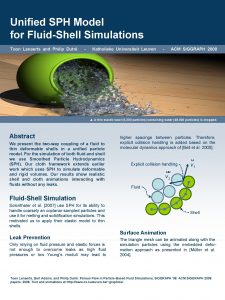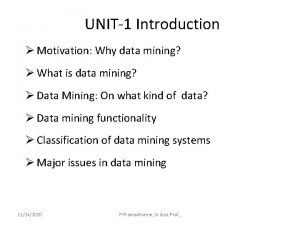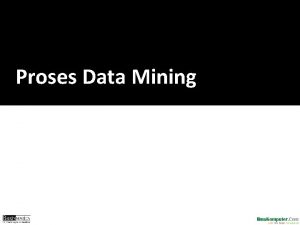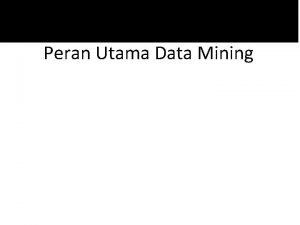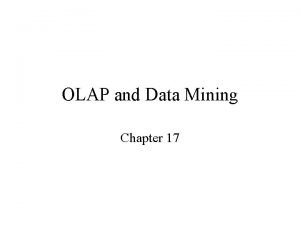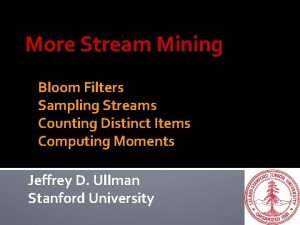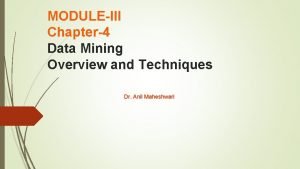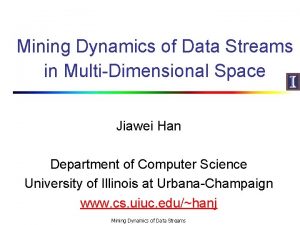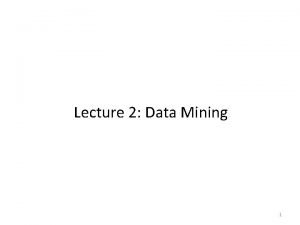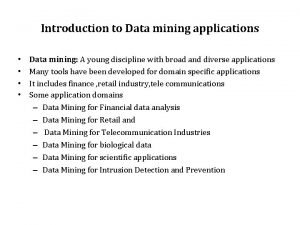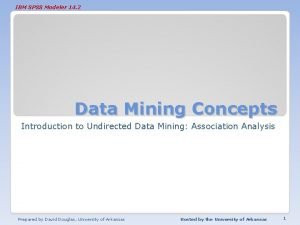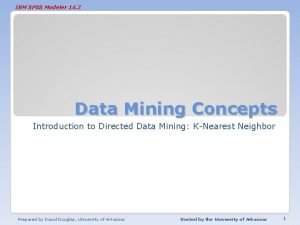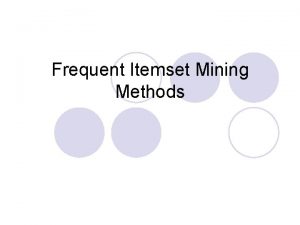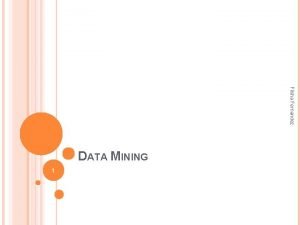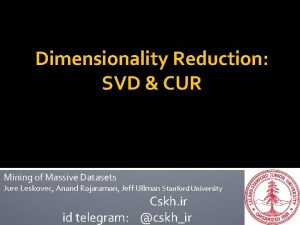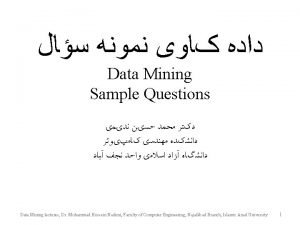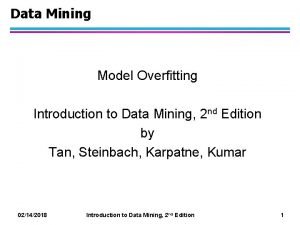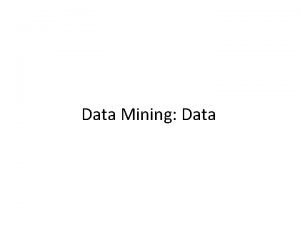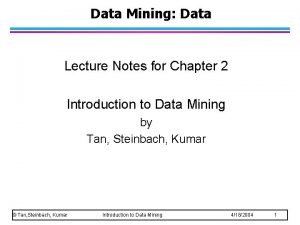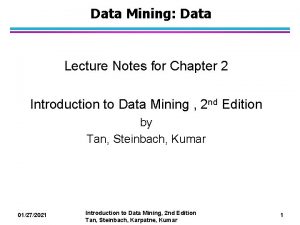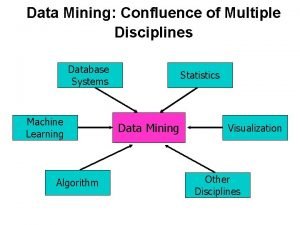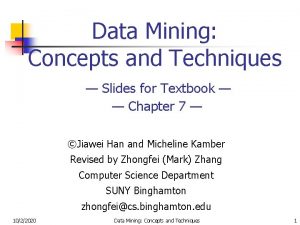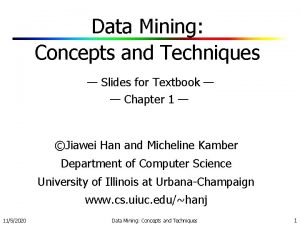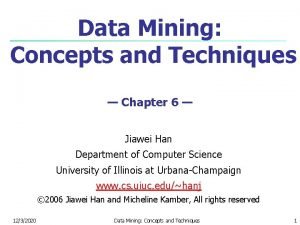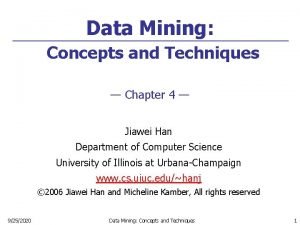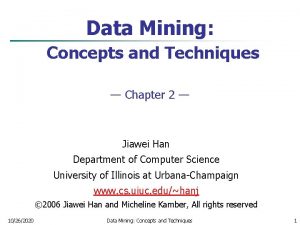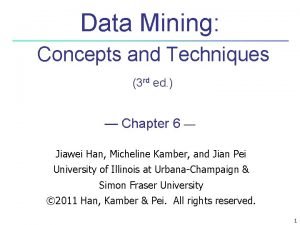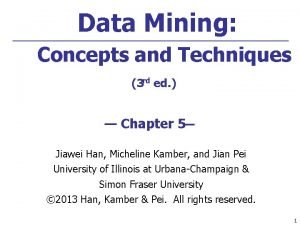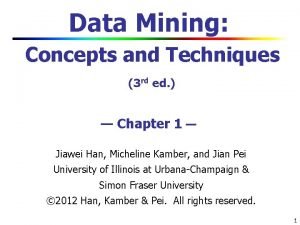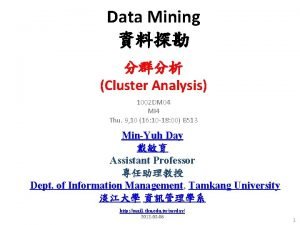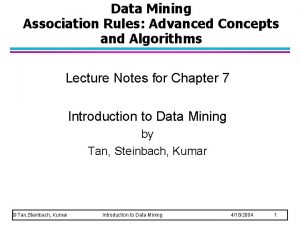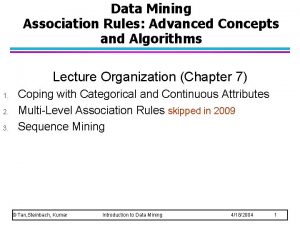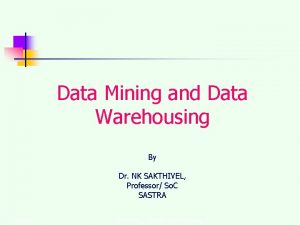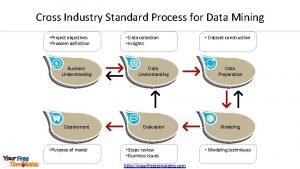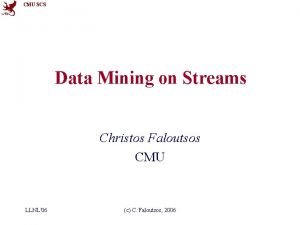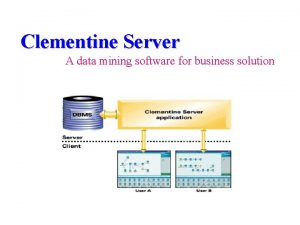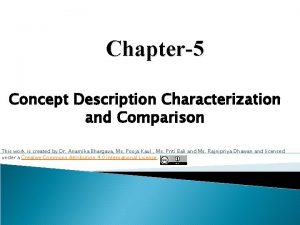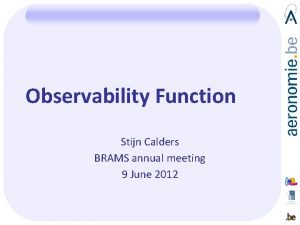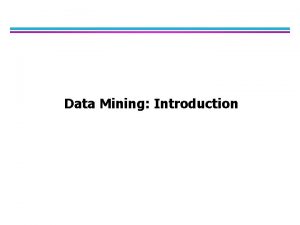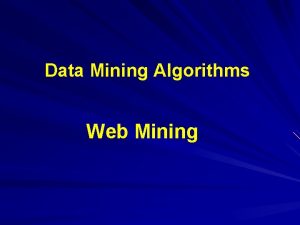Data Mining Toon Calders Why Data mining l







![Data Mining Tasks l Previous lectures: – Classification [Predictive] – Clustering [Descriptive] l This Data Mining Tasks l Previous lectures: – Classification [Predictive] – Clustering [Descriptive] l This](https://slidetodoc.com/presentation_image_h2/e6743df5b20de0d5cb50ffa153c45a08/image-8.jpg)








































![Depth-First Algorithm DB[C] DB 1 2 3 4 5 B, C A, C, D Depth-First Algorithm DB[C] DB 1 2 3 4 5 B, C A, C, D](https://slidetodoc.com/presentation_image_h2/e6743df5b20de0d5cb50ffa153c45a08/image-49.jpg)
![Depth-First Algorithm DB[C] DB 1 2 3 4 5 B, C A, C, D Depth-First Algorithm DB[C] DB 1 2 3 4 5 B, C A, C, D](https://slidetodoc.com/presentation_image_h2/e6743df5b20de0d5cb50ffa153c45a08/image-50.jpg)
![Depth-First Algorithm DB[C] DB 1 2 3 4 5 B, C A, C, D Depth-First Algorithm DB[C] DB 1 2 3 4 5 B, C A, C, D](https://slidetodoc.com/presentation_image_h2/e6743df5b20de0d5cb50ffa153c45a08/image-51.jpg)
![Depth-First Algorithm DB[C] DB 1 2 3 4 5 B, C A, C, D Depth-First Algorithm DB[C] DB 1 2 3 4 5 B, C A, C, D](https://slidetodoc.com/presentation_image_h2/e6743df5b20de0d5cb50ffa153c45a08/image-52.jpg)

![Depth-First Algorithm DB[B] DB 1 2 3 4 5 B, C A, C, D Depth-First Algorithm DB[B] DB 1 2 3 4 5 B, C A, C, D](https://slidetodoc.com/presentation_image_h2/e6743df5b20de0d5cb50ffa153c45a08/image-54.jpg)



































![Other Patterns in Sequences l l Substrings Regular expressions (bb|[^b]{2}) Partial orders Directed Acyclic Other Patterns in Sequences l l Substrings Regular expressions (bb|[^b]{2}) Partial orders Directed Acyclic](https://slidetodoc.com/presentation_image_h2/e6743df5b20de0d5cb50ffa153c45a08/image-90.jpg)




- Slides: 94

Data Mining Toon Calders

Why Data mining? l Explosive Growth of Data: from terabytes to petabytes – Data collection and data availability – Major sources of abundant data

Why Data mining? l We are drowning in data, but starving for knowledge! l “Necessity is the mother of invention”—Data mining— Automated analysis of massive data sets The Data Gap Total new disk (TB) since 1995 Number of analysts

What Is Data Mining? l Data mining (knowledge discovery from data) – Extraction of interesting (non-trivial, implicit, previously unknown and potentially useful) patterns or knowledge from huge amount of data l Alternative names – Knowledge discovery (mining) in databases (KDD), knowledge extraction, data/pattern analysis, data archeology, data dredging, information harvesting, business intelligence, etc.

Current Applications l Data analysis and decision support – Market analysis and management – Risk analysis and management – Fraud detection and detection of unusual patterns (outliers) l Other Applications – Text mining (news group, email, documents) and Web mining – Stream data mining – Bioinformatics and bio-data analysis

Ex. 3: Process Mining process mining l Process mining can be used for: – Process discovery (What is the process? ) – Delta analysis (Are we doing what was specified? ) – Performance analysis (How can we improve? )

Ex. 3: Process Mining case 1 : task A case 2 : task A case 3 : task B case 1 : task C case 2 : task C case 4 : task A case 2 : task B case 2 : task D case 5 : task E
![Data Mining Tasks l Previous lectures Classification Predictive Clustering Descriptive l This Data Mining Tasks l Previous lectures: – Classification [Predictive] – Clustering [Descriptive] l This](https://slidetodoc.com/presentation_image_h2/e6743df5b20de0d5cb50ffa153c45a08/image-8.jpg)
Data Mining Tasks l Previous lectures: – Classification [Predictive] – Clustering [Descriptive] l This lecture: – Association Rule Discovery [Descriptive] – Sequential Pattern Discovery [Descriptive] l Other techniques: – Regression [Predictive] – Deviation Detection [Predictive]

Outline of today’s lecture l Association Rule Mining – Frequent itemsets and association rules – Algorithms: Apriori and Eclat l Sequential Pattern Mining – Mining frequent episodes – Algorithms: Win. Epi and Min. Epi l Other types of patterns – strings, graphs, … – process mining

Association Rule Mining l Definition – Frequent itemsets – Association rules l Frequent itemset mining – breadth-first Apriori – depth-first Eclat l Association Rule Mining

Association Rule Mining l Given a set of transactions, find rules that will predict the occurrence of an item based on the occurrences of other items in the transaction Market-Basket transactions Example of Association Rules {Diaper} {Beer}, {Milk, Bread} {Eggs, Coke}, {Beer, Bread} {Milk}, Implication means co-occurrence, not causality!

Definition: Frequent Itemset l Itemset – A collection of one or more items u Example: {Milk, Bread, Diaper} – k-itemset u l An itemset that contains k items Support count ( ) – Frequency of occurrence of an itemset – E. g. ({Milk, Bread, Diaper}) = 2 l Support – Fraction of transactions that contain an itemset – E. g. s({Milk, Bread, Diaper}) = 2/5 l Frequent Itemset – An itemset whose support is greater than or equal to a minsup threshold

Definition: Association Rule l Association Rule – An implication expression of the form X Y, where X and Y are itemsets – Example: {Milk, Diaper} {Beer} l Rule Evaluation Metrics – Support (s) u Fraction of transactions that contain both X and Y – Confidence (c) u Measures how often items in Y appear in transactions that contain X Example:

Association Rule Mining Task l Given a set of transactions T, the goal of association rule mining is to find all rules having – support ≥ minsup threshold – confidence ≥ minconf threshold l Brute-force approach: – List all possible association rules – Compute the support and confidence for each rule – Prune rules that fail the minsup and minconf thresholds Computationally prohibitive!

Mining Association Rules Example of Rules: {Milk, Diaper} {Beer} (s=0. 4, c=0. 67) {Milk, Beer} {Diaper} (s=0. 4, c=1. 0) {Diaper, Beer} {Milk} (s=0. 4, c=0. 67) {Beer} {Milk, Diaper} (s=0. 4, c=0. 67) {Diaper} {Milk, Beer} (s=0. 4, c=0. 5) {Milk} {Diaper, Beer} (s=0. 4, c=0. 5) Observations: • All the above rules are binary partitions of the same itemset: {Milk, Diaper, Beer} • Rules originating from the same itemset have identical support but can have different confidence • Thus, we may decouple the support and confidence requirements

Mining Association Rules l Two-step approach: 1. Frequent Itemset Generation – Generate all itemsets whose support minsup 2. Rule Generation – l Generate high confidence rules from each frequent itemset, where each rule is a binary partitioning of a frequent itemset Frequent itemset generation is still computationally expensive

Association Rule Mining l Definition – Frequent itemsets – Association rules l Frequent itemset mining – breadth-first Apriori – depth-first Eclat l Association Rule Mining

Frequent Itemset Generation Given d items, there are 2 d possible candidate itemsets

Frequent Itemset Generation l Brute-force approach: – Each itemset in the lattice is a candidate frequent itemset – Count the support of each candidate by scanning the database – Match each transaction against every candidate – Complexity ~ O(NMw) => Expensive since M = 2 d !!!

Frequent Itemset Generation Strategies l Reduce the number of candidates (M) – Complete search: M=2 d – Use pruning techniques to reduce M l Reduce the number of transactions (N) – Reduce size of N as the size of itemset increases – Used by DHP and vertical-based mining algorithms l Reduce the number of comparisons (NM) – Use efficient data structures to store the candidates or transactions – No need to match every candidate against every transaction

Reducing Number of Candidates l Apriori principle: – If an itemset is frequent, then all of its subsets must also be frequent l Apriori principle holds due to the following property of the support measure: – Support of an itemset never exceeds the support of its subsets – This is known as the anti-monotone property of support

Illustrating Apriori Principle Found to be Infrequent Pruned supersets

Illustrating Apriori Principle Items (1 -itemsets) Pairs (2 -itemsets) (No need to generate candidates involving Coke or Eggs) Minimum Support = 3 If every subset is considered, 6 C + 6 C = 41 1 2 3 With support-based pruning, 6 + 1 = 13 Triplets (3 -itemsets)

Association Rule Mining l Definition – Frequent itemsets – Association rules l Frequent itemset mining – breadth-first Apriori – depth-first Eclat l Association Rule Mining

Apriori 1 2 3 4 5 B, C A, C, D A, B, C, D B, D minsup=2 Candidates A 0 B C 0 0 {} D 0

Apriori 1 2 3 4 5 B, C A, C, D A, B, C, D B, D minsup=2 Candidates A 0 B C 1 1 {} D 0

Apriori 1 2 3 4 5 B, C A, C, D A, B, C, D B, D minsup=2 Candidates A 0 B C 2 2 {} D 0

Apriori 1 2 3 4 5 B, C A, C, D A, B, C, D B, D minsup=2 Candidates A 1 B C 3 2 {} D 1

Apriori 1 2 3 4 5 B, C A, C, D A, B, C, D B, D minsup=2 Candidates A 2 B C 4 3 {} D 2

Apriori 1 2 3 4 5 B, C A, C, D A, B, C, D B, D minsup=2 Candidates A 2 B C 4 4 {} D 3

Apriori 1 2 3 4 5 B, C A, C, D A, B, C, D B, D minsup=2 Candidates AB AC A 2 AD B BC BD C 4 4 {} CD D 3

Apriori 1 2 3 4 5 B, C A, C, D A, B, C, D B, D minsup=2 AB AC 1 A 2 2 AD B BC 2 3 C 4 4 {} BD CD 2 2 D 3

Apriori 1 2 3 4 5 B, C A, C, D A, B, C, D B, D Candidates minsup=2 ACD AB AC 1 A 2 2 AD B BC 2 3 C 4 4 {} BCD BD CD 2 2 D 3

Apriori 1 2 3 4 5 B, C A, C, D A, B, C, D B, D minsup=2 ACD 2 AB AC 1 A 2 2 AD B BC 2 3 C 4 4 {} BD BCD 1 2 CD 2 D 3

Apriori Algorithm l Apriori Algorithm: k : = 1 C 1 : = { {A} | A is an item} Repeat until Ck = {} Count the support of each candidate in Ck – in one scan over DB Fk : = { I Ck : I is frequent} Generate new candidates Ck+1 : = { I : |I| = k+1 and all J I with |J|=k are in Fk} k: =k+1 Return i=1…k-1 Fi

Association Rule Mining l Definition – Frequent itemsets – Association rules l Frequent itemset mining – breadth-first Apriori – depth-first Eclat l Association Rule Mining

Depth-first strategy l Recursive procedure – FSET(DB) = frequent sets in DB l Based on divide-and-conquer – Count frequency of all items ulet D be a frequent item – FSET(DB) = Frequent sets with item D + Frequent sets without item D

Depth-first strategy l Frequent items – A, B, C, D l Frequent sets with D: – remove transactions without D and D itself from DB – Count frequent sets: A, B, C, AC – Append D: AD, BD, CD, ACD l Frequent sets without D: – remove D from all transactions in DB – Find frequent sets: AC, BC 1 2 3 4 5 B, C A, C, D A, B, C, D B, D 1 2 3 4 5 B, C A, C, D A, B, C, D B, D

Depth-First Algorithm DB 1 2 3 4 5 B, C A, C, D A, B, C, D B, D minsup=2

Depth-First Algorithm DB 1 2 3 4 5 B, C A, C, D A, B, C, D B, D A: 2 B: 4 C: 4 D: 3 minsup=2

Depth-First Algorithm minsup=2 DB 1 2 3 4 5 B, C A, C, D A, B, C, D B, D A: 2 B: 4 C: 4 D: 3 DB[D] 3 4 5 A, C A, B, C B, A: 2 B: 2 C: 2

Depth-First Algorithm minsup=2 DB 1 2 3 4 5 B, C A, C, D A, B, C, D B, D A: 2 B: 4 C: 4 D: 3 DB[D] 3 4 5 A, C A, B, C B, A: 2 B: 2 C: 2 DB[CD] 3 4 A, A, B A: 2

Depth-First Algorithm minsup=2 DB 1 2 3 4 5 B, C A, C, D A, B, C, D B, D A: 2 B: 4 C: 4 D: 3 DB[D] 3 4 5 A, C A, B, C B, A: 2 B: 2 C: 2 AC: 2 DB[CD] 3 4 A, A, B A: 2

Depth-First Algorithm minsup=2 DB 1 2 3 4 5 B, C A, C, D A, B, C, D B, D A: 2 B: 4 C: 4 D: 3 DB[D] 3 4 5 A, C A, B, C B, A: 2 B: 2 C: 2 AC: 2

Depth-First Algorithm minsup=2 DB 1 2 3 4 5 B, C A, C, D A, B, C, D B, D A: 2 B: 4 C: 4 D: 3 DB[D] 3 4 5 A, C A, B, C B, A: 2 B: 2 C: 2 AC: 2 DB[BD] 4 A A: 1

Depth-First Algorithm minsup=2 DB 1 2 3 4 5 B, C A, C, D A, B, C, D B, D A: 2 B: 4 C: 4 D: 3 DB[D] 3 4 5 A, C A, B, C B, A: 2 B: 2 C: 2 AC: 2

Depth-First Algorithm minsup=2 DB 1 2 3 4 5 B, C A, C, D A, B, C, D B, D A: 2 B: 4 C: 4 D: 3 AD: 2 BD: 2 CD: 2 ACD: 2 DB[D] 3 4 5 A, C A, B, C B, A: 2 B: 2 C: 2 AC: 2

Depth-First Algorithm DB 1 2 3 4 5 B, C A, C, D A, B, C, D B, D A: 2 B: 4 C: 4 D: 3 AD: 2 BD: 2 CD: 2 ACD: 2 minsup=2
![DepthFirst Algorithm DBC DB 1 2 3 4 5 B C A C D Depth-First Algorithm DB[C] DB 1 2 3 4 5 B, C A, C, D](https://slidetodoc.com/presentation_image_h2/e6743df5b20de0d5cb50ffa153c45a08/image-49.jpg)
Depth-First Algorithm DB[C] DB 1 2 3 4 5 B, C A, C, D A, B, C, D B, D A: 2 B: 4 C: 4 D: 3 AD: 2 BD: 2 CD: 2 ACD: 2 1 2 3 4 B B A A, B A: 2 B: 3 minsup=2
![DepthFirst Algorithm DBC DB 1 2 3 4 5 B C A C D Depth-First Algorithm DB[C] DB 1 2 3 4 5 B, C A, C, D](https://slidetodoc.com/presentation_image_h2/e6743df5b20de0d5cb50ffa153c45a08/image-50.jpg)
Depth-First Algorithm DB[C] DB 1 2 3 4 5 B, C A, C, D A, B, C, D B, D A: 2 B: 4 C: 4 D: 3 AD: 2 BD: 2 CD: 2 ACD: 2 1 2 3 4 B B A A, B A: 2 B: 3 DB[BC] 1 2 4 A A: 1 minsup=2
![DepthFirst Algorithm DBC DB 1 2 3 4 5 B C A C D Depth-First Algorithm DB[C] DB 1 2 3 4 5 B, C A, C, D](https://slidetodoc.com/presentation_image_h2/e6743df5b20de0d5cb50ffa153c45a08/image-51.jpg)
Depth-First Algorithm DB[C] DB 1 2 3 4 5 B, C A, C, D A, B, C, D B, D A: 2 B: 4 C: 4 D: 3 AD: 2 BD: 2 CD: 2 ACD: 2 1 2 3 4 B B A A, B A: 2 B: 3 minsup=2
![DepthFirst Algorithm DBC DB 1 2 3 4 5 B C A C D Depth-First Algorithm DB[C] DB 1 2 3 4 5 B, C A, C, D](https://slidetodoc.com/presentation_image_h2/e6743df5b20de0d5cb50ffa153c45a08/image-52.jpg)
Depth-First Algorithm DB[C] DB 1 2 3 4 5 B, C A, C, D A, B, C, D B, D A: 2 B: 4 C: 4 D: 3 AD: 2 BD: 2 CD: 2 AC: 2 BC: 3 1 2 3 4 B B A A, B A: 2 B: 3 minsup=2

Depth-First Algorithm DB 1 2 3 4 5 B, C A, C, D A, B, C, D B, D A: 2 B: 4 C: 4 D: 3 AD: 2 BD: 2 CD: 2 AC: 2 BC: 3 minsup=2
![DepthFirst Algorithm DBB DB 1 2 3 4 5 B C A C D Depth-First Algorithm DB[B] DB 1 2 3 4 5 B, C A, C, D](https://slidetodoc.com/presentation_image_h2/e6743df5b20de0d5cb50ffa153c45a08/image-54.jpg)
Depth-First Algorithm DB[B] DB 1 2 3 4 5 B, C A, C, D A, B, C, D B, D A: 2 B: 4 C: 4 D: 3 AD: 2 BD: 2 CD: 2 AC: 2 BC: 3 1 2 4 5 A A: 1 minsup=2

Depth-First Algorithm DB 1 2 3 4 5 B, C A, C, D A, B, C, D B, D A: 2 B: 4 C: 4 D: 3 AD: 2 BD: 2 CD: 2 AC: 2 BC: 3 minsup=2

Depth-First Algorithm minsup=2 DB 1 2 3 4 5 B, C A, C, D A, B, C, D B, D A: 2 B: 4 C: 4 D: 3 AD: 2 BD: 2 CD: 2 AC: 2 BC: 3 Final set of frequent itemsets

Depth-first strategy FSET(DB): 1. Count frequency of items in DB 2. F : = { A | A is frequent in DB } 3. // Remove infrequent items from DB DB : = { T F : T DB } 4. For all frequent items D except last one do: // Find frequent, strict supersets of {D} in DB: 4 a. Let DB[D] : = { T {D} | T DB, D T } 4 b. F : = F { (I D) : I in FSET(DB[D]) } 4 c. // Remove D from DB DB : = { T {D} : T DB } 5. Return F

Depth-first strategy All depth-first algorithms use this strategy l Difference = data structure for DB l – prefix-tree: FPGrowth – vertical database: Eclat

ECLAT l For each item, store a list of transaction ids (tids) TID-list

ECLAT Support of item A = length of its tidlist l Remove item A from DB: remove tidlist of A l Create conditional database DB[E]: l – Intersect all other tidlists with the tidlist of E – Only keep frequent items A 1 4 5 6 7 8 9 B 1 2 5 7 8 10 C 2 3 4 8 9 D 2 4 5 9 E 1 3 6 A 1 6 B 1 A 1 6 C 3 B 1 D C 3

Association Rule Mining l Definition – Frequent itemsets – Association rules l Frequent itemset mining – breadth-first Apriori – depth-first Eclat l Association Rule Mining

Association Rule Mining l Remember: – original problem: find rules X Y such that usupport(XY) minsup / support(X) minconf – Frequent itemsets = the combinations XY l Hence: – Get XY by splitting up the frequent itemsets I

Rule Generation l Given a frequent itemset L, find all non-empty subsets f L such that f L – f satisfies the minimum confidence requirement – If {A, B, C, D} is a frequent itemset, candidate rules: ABC D, A BCD, AB CD, BD AC, l ABD C, B ACD, AC BD, CD AB, ACD B, C ABD, AD BC, BCD A, D ABC BC AD, If |L| = k, then there are 2 k – 2 candidate association rules (ignoring L and L)

Rule Generation l How to efficiently generate rules from frequent itemsets? – In general, confidence does not have an antimonotone property c(ABC D) can be larger or smaller than c(AB D) – But confidence of rules generated from the same itemset has an anti-monotone property – e. g. , L = {A, B, C, D}: c(ABC D) c(AB CD) c(A BCD) Confidence is anti-monotone w. r. t. number of items on the RHS of the rule u

Rule Generation for Apriori Algorithm Lattice of rules Low Confidence Rule Pruned Rules

Summary: Association Rule Mining l Find associations X Y – rule appears in sufficient large part of the database – conditional probability P(Y | X) is high l This problem can be split into two sub-problems: – find frequent itemsets – split frequent itemsets to get association rules l Finding frequent itemsets: – Apriori-property – breadth-first vs depth-first algorithms l From itemsets to association rules – split up frequent sets, use anti-monotonicity

Outline l Association Rule Mining – Frequent itemsets and association rules – Algorithms: Apriori and Eclat l Sequential Pattern Mining – Mining frequent episodes – Algorithms: Win. Epi and Min. Epi l Other types of patterns – strings, graphs, … – process mining

Series and Sequences In many applications, the order and transaction times are very important: – stock prices – events in a networking environment ucrash, starting a program, certain commands Specific format of the data is very important Goal: find “temporal rules”, order is important.

Series and Sequences Example – 70 % of the customers that buy shoes and socks, will buy shoe polish within 5 days. – User U 1 logging on, followed by User U 2 starting program P, is always followed by a crash. l Here, we will concentate on the problem of finding frequent episodes – can be used in the same way as itemsets – split episodes to get the rules

Episode Mining Event sequence: sequence of pairs (e, t), e is an event, t an integer indicating the time of occurrence of e. l An linear episode is a sequence of events <e 1, …, en>. l A window of length w is an interval [s, e] with (e-s+1) = w. l An episode E=<e 1, …, en> occurs in sequence S=<(s 1, t 1), …, (sm, tm)> within window W=[s, e] if there exist integers s i 1 < … < in e such that for all j=1…n, (ej, ij) is in S.

Episode mining: support measure l Given a sequence S Find all linear episodes that occur frequently in S

Episode mining: support measure l Given a sequence S Find all linear episodes that occur frequently in S l Given an integer w. The w-support of an episode E=<e 1, …, en> in a sequence S=<(s 1, t 1), …, (sm, tm)> is the number of windows W of length w such that E occurs in S within window W. Note: If an episode occurs in a very short time span, it will be in many subsequent windows, and thus contribute a lot to the support count!

Example S = < b a a c E = < b a c > b a a b c > E occurs in S within window [0, 4], within [1, 4], within [5, 9], … The 5 -support of E in S is 3, since E is only in the following windows of length 5: [0, 4], [1, 5], [5, 9] b a a c b a a b c

l An episode E 1=<e 1, …, en> is a sub-episode of E 2=<f 1, …, fm>, denoted E 1 E 2 if there exist integers 1 i 1 < … < in m such that for all j=1…n, ej=fij. Example < b, a, a, c > is a sub-episode of <a, b, c, a, a, b, c>.

Episode Mining Problem Given a sequence w, a minimal support minsup, and a window width w, find all episodes that have a w-support above minsup. Monotonicity Let S be a sequence, E 1, E 2 episodes, w a number. If E 1 E 2, then the w-support(E 2) w-support(E 1).

Win. Epi Algorithm We can again apply a level-wise algorithm like Apriori. l Start with small episodes, only proceed with a larger episode if all sub-episodes are frequent. <a, a, b> is evaluated after <a>, <b>, <a, a>, <a, b>, and only if all these episodes were frequent. l Counting the frequency: – slide window over stream – use smart update technique for the supports

Search space <a> <a, b> <a, c> <a, a, a> <a, a, b> <a, a, a, a> <a, a, a, b> <b, a> <a, a, c> … <b, b> <a, b, a> <c> <b, c> <c, a> <a, b, b> … <c, b> <c, c> <a, b, c> … … … Number of episodes of length k: ek (e is number of events) An episode of length k has maximally k sub-sequences of length k-1. We can count supports by sliding a window over the sequence.

Example S = < (a, 1), (b, 2), (c, 4), (b, 5), (b, 6), (a, 7), (b, 8), (b, 9), (c, 13), (a, 14), (c, 17), (c, 18) > w = 4, minsup = 3 0 1 2 a l b c b b a b C 1 = { <a>, <b>, <c> } b c a c c

Example S = < (a, 1), (b, 2), (c, 4), (b, 5), (b, 6), (a, 7), (b, 8), (b, 9), (c, 13), (a, 14), (c, 17), (c, 18) > w = 4, minsup = 3 0 1 2 a l b c b b a b b c C 1 = { <a>, <b>, <c> } Slide window of length 4 over S: 4 -supports: <a>: 12, <b>: 12, <c>: 14 a c c

Example S = < (a, 1), (b, 2), (c, 4), (b, 5), (b, 6), (a, 7), (b, 8), (b, 9), (c, 13), (a, 14), (c, 17), (c, 18) > w = 4, minsup = 3 0 1 2 a l b c b b a b b c a c c C 1 = { <a>, <b>, <c> } Slide window of length 4 over S: 4 -supports: <a>: 12, <b>: 12, <c>: 14 l C 2 = { <a, a>, <a, b>, <a, c>, <b, a>, <b, b>, <b, c>, <c, a>, <c, b>, <c, c> }

Example S = < (a, 1), (b, 2), (c, 4), (b, 5), (b, 6), (a, 7), (b, 8), (b, 9), (c, 13), (a, 14), (c, 17), (c, 18) > w = 4, minsup = 3 0 1 2 a l b c b b a b b c a c c C 1 = { <a>, <b>, <c> } Slide window of length 4 over S: 4 -supports: <a>: 12, <b>: 12, <c>: 14 l C 2 = { <a, a>, <a, b>, <a, c>, <b, a>, <b, b>, <b, c>, <c, a>, <c, b>, <c, c> } 4 -supports: <a, a>: 0 <b, b>: 7 <b, c>: 3 <a, b>: 6 <a, c>: 2 <b, a>: 3 <c, b>: 1 <c, c>: 3

Example S = < (a, 1), (b, 2), (c, 4), (b, 5), (b, 6), (a, 7), (b, 8), (b, 9), (c, 13), (a, 14), (c, 17), (c, 18) > w = 4, minsup = 3 0 1 2 a l b c b b a b b c a c c C 1 = { <a>, <b>, <c> } Slide window of length 4 over S: 4 -supports: <a>: 12, <b>: 12, <c>: 14 l C 2 = { <a, a>, <a, b>, <a, c>, <b, a>, <b, b>, <b, c>, <c, a>, <c, b>, <c, c> } 4 -supports: <a, a>: 0 <b, b>: 7 l <b, c>: 3 <a, b>: 6 <a, c>: 2 <b, a>: 3 <c, b>: 1 <c, c>: 3 C 3 = { <a, b, b>, <b, a, b>, <b, b, a>, <b, b, b>, <b, b, c>, <b, c, a>, <b, c, c>, <c, c, a>, <c, c, c>} 4 -supports: <a, b, b>: 2, <b, a, b>: 2, <b, b, a>: 2, <b, b, b>: 2, <b, b, c>: 0, <b, c, c>: 0, <c, c, a>: 0, <c, c, c>: 0 <b, c, a>: 0,

Min. Epi Very similar algorithm l based on other support measure l – minimal occurrence of sequence: smallest window in which the sequence occurs – support of E = number of minimal occurrences of E with a width less than w S = < a b c b b a b b c a c c c b b> 5 -support of < a b b > : mo-support of < a b b > : window length = 5

Min. Epi Very similar algorithm l based on other support measure l – minimal occurrence of sequence: smallest window in which the sequence occurs – support of E = number of minimal occurrences of E with a width less than w S = < a b c b b a b b c a c c c b b> window length = 5 5 -support of < a b b > : 5 a b c b b a b b c a c c c b b mo-support of < a b b >

Min. Epi Very similar algorithm l based on other support measure l – minimal occurrence of sequence: smallest window in which the sequence occurs – support of E = number of minimal occurrences of E with a width less than w S = < a b c b b a b b c a c c c b b> window length = 5 5 -support of < a b b > : 5 a b c b b a b b c a c c c b b mo-support of < a b b > : 2 a b c b b a b b c a c c c b b

Sequential Pattern Mining: Summary Mining sequential episodes l Two definitions of support: l – w-support – mo-support l Two algorithms: – Win. Epi – Min. Epi l Based on monotonicity principle – generate candidates levelwise – only count candidates without infrequent subsequences

Outline l Association Rule Mining – Frequent itemsets and association rules – Algorithms: Apriori and Eclat l Sequential Pattern Mining – Mining frequent episodes – Algorithms: Win. Epi and Min. Epi l Other types of patterns – strings, graphs, … – process mining

Other types of patterns l Sequence problems – Strings – Other types of sequences – Oher patterns in sequences l Graphs – Molecules – WWW – Social Networks l …

Other Types of Sequences CGATGGGCCAGTCGATACGTCGATGCCGATGTCACG
![Other Patterns in Sequences l l Substrings Regular expressions bbb2 Partial orders Directed Acyclic Other Patterns in Sequences l l Substrings Regular expressions (bb|[^b]{2}) Partial orders Directed Acyclic](https://slidetodoc.com/presentation_image_h2/e6743df5b20de0d5cb50ffa153c45a08/image-90.jpg)
Other Patterns in Sequences l l Substrings Regular expressions (bb|[^b]{2}) Partial orders Directed Acyclic Graphs

Graphs

Patterns in Graphs

Rules f: 5 0. 8 f: 4 f: 7 f: 8 0. 57 f: 4

Summary l What is data mining and why is it important. – huge volumes of data – not enough human analysts l Pattern discovery as an important descriptive data mining task – association rule mining – sequential pattern mining l Important principles: – Apriori principle – breadth-first vs depth-first algorithms l Many kinds and variaties of data-types, pattern types, support measures, …
 Toon calders
Toon calders Eclat algorithm
Eclat algorithm Escola pere calders
Escola pere calders Mining complex types of data
Mining complex types of data Andreas carlsson bye bye bye
Andreas carlsson bye bye bye Mining multimedia databases in data mining
Mining multimedia databases in data mining Sph toon
Sph toon Dokter toon mortelmans
Dokter toon mortelmans Citetation
Citetation Gedicht fiets toon hermans
Gedicht fiets toon hermans Toon company
Toon company Toon blast 6500
Toon blast 6500 Dr toon mortelmans
Dr toon mortelmans Vray toon shader maya
Vray toon shader maya Ger construction
Ger construction Toon koppelaars
Toon koppelaars Gl toon
Gl toon Pow toon 4 edu
Pow toon 4 edu Flanders hydraulics research
Flanders hydraulics research Dont ask why why why
Dont ask why why why Strip mining vs open pit mining
Strip mining vs open pit mining Strip mining before and after
Strip mining before and after Difference between strip mining and open pit mining
Difference between strip mining and open pit mining Text and web mining
Text and web mining Data reduction in data mining
Data reduction in data mining What is data mining and data warehousing
What is data mining and data warehousing What is missing data in data mining
What is missing data in data mining Concept hierarchy generation for nominal data
Concept hierarchy generation for nominal data Data reduction in data mining
Data reduction in data mining Data reduction in data mining
Data reduction in data mining Shell cube in data mining
Shell cube in data mining Data reduction in data mining
Data reduction in data mining Arsitektur data mining
Arsitektur data mining Perbedaan data warehouse dan data mining
Perbedaan data warehouse dan data mining Data mining dan data warehouse
Data mining dan data warehouse Multidimensional analysis and descriptive mining of complex
Multidimensional analysis and descriptive mining of complex Olap data warehouse
Olap data warehouse Noisy data in data mining
Noisy data in data mining Rolap in data warehouse
Rolap in data warehouse Markku roiha
Markku roiha Data compression in data mining
Data compression in data mining Introduction to data warehouse
Introduction to data warehouse Data warehouse dan data mining
Data warehouse dan data mining Cs 412 introduction to data mining
Cs 412 introduction to data mining Unsupervised learning in data mining
Unsupervised learning in data mining Motivation of data mining
Motivation of data mining Data mining slides
Data mining slides Reporting and query tools
Reporting and query tools Pump it up: data mining the water table
Pump it up: data mining the water table Sebutkan tahapan utama proses data mining!
Sebutkan tahapan utama proses data mining! Sebutkan peran utama data mining
Sebutkan peran utama data mining Olap stands for: *
Olap stands for: * Bloom filter for stream data mining
Bloom filter for stream data mining Data mining steps
Data mining steps Data mining midterm exam with solutions
Data mining midterm exam with solutions Multidimensional space in data mining
Multidimensional space in data mining Data mining roadmap
Data mining roadmap Pentaho data mining
Pentaho data mining Spatial data mining applications
Spatial data mining applications Walmart data mining
Walmart data mining Data mining spss
Data mining spss Spss 14
Spss 14 Frequent itemset mining methods
Frequent itemset mining methods Objective of data mining
Objective of data mining Emr data mining
Emr data mining Cur decomposition in data mining
Cur decomposition in data mining Dss in data mining
Dss in data mining 6-8-10 square rule
6-8-10 square rule Underfitting and overfitting in data mining
Underfitting and overfitting in data mining Svd data mining
Svd data mining Data mining lectures
Data mining lectures Data mining functionalities
Data mining functionalities Collection of data objects
Collection of data objects Correlation data mining
Correlation data mining Types of attributes in data mining
Types of attributes in data mining Confluence miner
Confluence miner Information gain in data mining
Information gain in data mining Data mining concepts and techniques slides
Data mining concepts and techniques slides Overfitting and underfitting in data mining
Overfitting and underfitting in data mining Shell cube in data mining
Shell cube in data mining Types of attributes in data mining
Types of attributes in data mining Downward closure property in data mining
Downward closure property in data mining Shell cube in data mining
Shell cube in data mining Function of data mining
Function of data mining What is a cluster in data mining
What is a cluster in data mining Types of attributes in data mining
Types of attributes in data mining Association analysis advanced concepts
Association analysis advanced concepts Example of descriptive data mining
Example of descriptive data mining Database vs data mining
Database vs data mining Supervised data mining
Supervised data mining Semma
Semma Data mining cmu
Data mining cmu Clementine server
Clementine server Characterization and comparison in data mining
Characterization and comparison in data mining Data mining primitives languages and system architecture
Data mining primitives languages and system architecture






